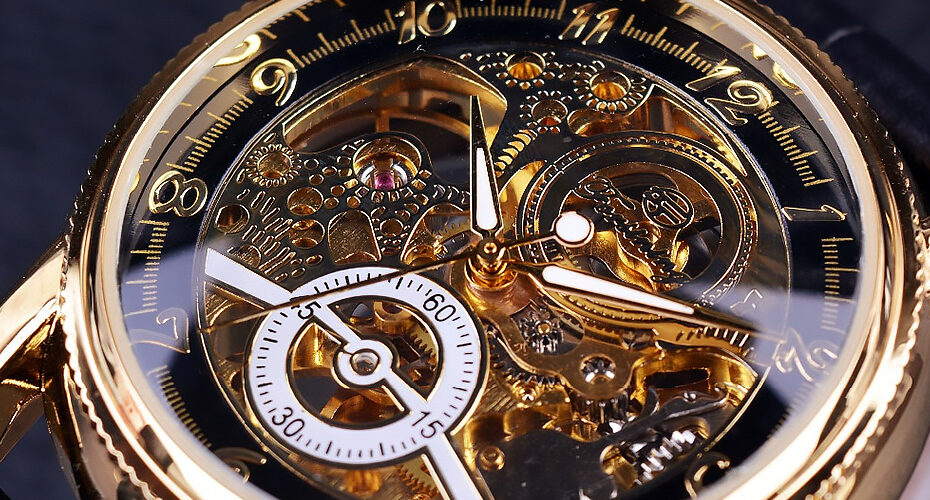Automatic watches are hot in the United States. Between 1993 and 1995, U.S. imports of Swiss luxury automatics jumped 95%. Just what are automatics? How do they work? How accurate are they? How often should they be serviced? For answers to these and other questions, read on.
- What is an automatic watch?
- Is that the same as a hand-wound watch?
- Why do they call it “automatic?”
- What is the difference between an automatic and a self-winding watch?
- Is that the same thing as a “perpetual” watch, like a Rolex Oyster Perpetual?
- How does an automatic watch work?
- Who invented the automatic watch?
- Why do we see more automatics these days?
- How popular are they in the United States?
- Why are they so popular?
- Are they expensive?
- How much motion does an automatic need to work properly?
- Is it safe to wind an automatic watch?
- How long will an automatic watch keep turning off the wrist?
- How often does an automatic need to be serviced?
1. What is an automatic watch?
An automatic is a mechanical watch whose mainspring is wound as a result of the wearer’s arm motion.
2. Is that the same as a hand-wound watch?
No. Hand-wound is a mechanical watch that the wearer winds by turning the crown by hand.
3. Why do they call it “automatic?”
Because instead of the wearer having to wind the watch to generate power, the watch winds itself “automatically” when worn.
4. What is the difference between an automatic and a self-winding watch?
Nothing. The terms are synonymous. Self-winding means that the watch winds itself.
5. Is that the same thing as a “perpetual” watch, like a Rolex Oyster Perpetual?
Right. Rolex refers to its automatic watches as “perpetuals.” Automatic, self-winding and perpetual all mean the same thing: the watch winds itself. (A perpetual calendar, however, is something else.)
6. How does an automatic watch work?
The movement of the wrist and body causes the rotor, a metal weight attached to a winding mechanism, to pivot freely on its staff in the center of the movement. The rotor rotates back and forth in a circular motion at the slightest action of the wrist. The rotor’s movement winds the mainspring, a flat coiled spring that powers mechanical watches.
7. Who invented the automatic watch?
The modern rotor system was developed and patented by Rolex and introduced into the Oyster line as the Oyster Perpetual in 1931. Emile Borer, Rolex’s technical chief at the time, is credited with inventing the modern rotor system.
The person who first developed a rotor, however, was Abraham-Louis Perrelet (1729-1826), one of Switzerland’s greatest watchmakers. Perrelet is considered the father of the automatic watch. He introduced the concept in 1770 and was way ahead of his time since the invention was better suited to wristwatches. Perrelet lived in the pocket watch era and, because the watches did not move much in pockets, the rotor system did not perform so well. The rotor did not move around enough to wind the mainspring sufficiently.
Abraham-Louis Breguet (1747-1823) improved self-winding watches; he called them “perpetuelles” (the likely source of Rolex’s term). Other watchmaking greats of the 19th century advanced the concept. But it wasn’t until wristwatches became popular after World War I and Rolex perfected its system that automatics came into their own.
8. Why do we see more automatics these days?
Like all mechanical watches, automatics fell out of style during the quartz watch revolution of the 1970s. Electronic watches were the rage then and were far more accurate than mechanicals. In the mid-1980s, however, as quartz watch production soared to hundreds of millions of pieces each year, some people, mostly watch collectors, began to appreciate the value of a fine mechanical watch. In the past 10 years, fine mechanical watches have staged a comeback on world markets. Automatics have rebounded as part of the mechanical counter-revolution.
9. How popular are they in the United States?
Very. Between 1993 and 1995, U.S. imports of Swiss luxury mechanical watches jumped 95% in units and 87% in value, according to the American Watch Association. This data also includes hand-wound watches, but the majority are automatics. Data for 1996 is not available yet.
10. Why are they so popular?
Many people appreciate the craft involved in making a mechanical automatic movement. They like the fact that this technology is hundreds of years old, involves many moving parts, yet keeps very accurate time. (Many automatics come with glass backs which enable the wearer to view the action of the rotor and other moving parts.) They appreciate the human element involved in an automatic watch, that the movement is assembled by hand. Others like the fact that automatics run on so-called “clean,” natural energy–wrist power–and that there are no polluting batteries to dispose of.
11. How accurate are they?
Mechanical technology, by definition, is inferior to the extreme accuracy of an electronic watch. Automatics are plenty accurate for normal daily timekeeping, though. A normal automatic is accurate to within +30/-5 seconds a day, depending on the quality of the movement.
12. Are they expensive?
They can be, but they are not necessarily. Automatics are available in every price range, starting with Swatch automatics.
13. How much motion does an automatic need to work properly?
A person’s normal arm and wrist motion will keep an automatic watch properly wound. People who are inactive–the elderly or patients confined to beds–may need to wind their watch to keep it powered.
14. Is it safe to wind an automatic watch?
Sure. Winding the watch won’t hurt it at all. If you haven’t worn an automatic in a while, it is best to wind the stopped watch before putting it on. Ten to 15 turns of the crown is usually enough to give full power to the mainspring. Some companies recommend more: Breitling, for example, suggests turning the crown on its automatics 30 to 40 times. But be aware that the barrel in an automatic movement doesn’t have a hook so that you won’t feel any resistance when the mainspring is fully wound. Don’t worry; you can’t overwind the watch.
15. How long will an automatic watch keep turning off the wrist?
That depends on the type of movement in the watch and how much power is left in the mainspring when you take it off.
A normal, fully wound automatic movement will keep running from 36 to 48 hours. Frederic Piguet, the Swiss movement manufacturer which specializes in complicated movements, produces an automatic movement which stores 100 hours of power. Bernhard Stoeber, vice president of technical services at the Movado Group, recommends winding an automatic watch when one takes it off so that it will keep running as long as possible when not worn. Stoeber also suggests occasionally winding an automatic that is not worn for an extended period of time in order to keep the oils properly lubricated and distributed.
16. How often does an automatic need to be serviced?
Most companies recommend the watch be checked and relubricated every three to five years. If the wearer regularly subjects a water-resistant automatic to water, the seals should be checked annually.

